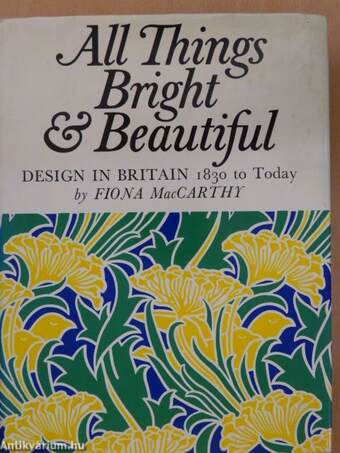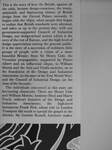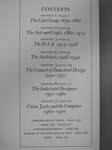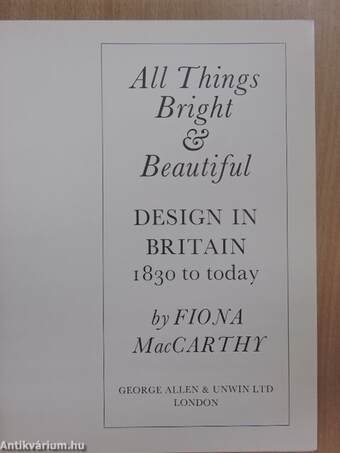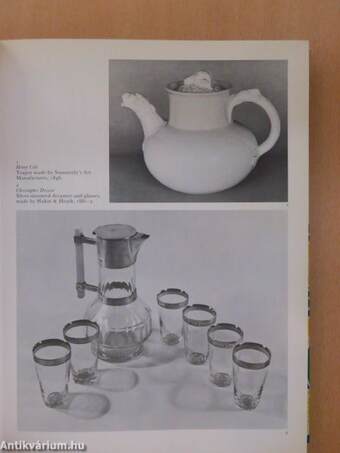1.116.679
kiadvánnyal nyújtjuk Magyarország legnagyobb antikvár könyv-kínálatát
All Things Bright & Beautiful
Design in Britain 1830 to today
| Kiadó: | George Allen & Unwin Ltd |
|---|---|
| Kiadás helye: | London |
| Kiadás éve: | |
| Kötés típusa: | Fűzött keménykötés |
| Oldalszám: | 327 oldal |
| Sorozatcím: | |
| Kötetszám: | |
| Nyelv: | Angol |
| Méret: | 25 cm x 20 cm |
| ISBN: | 0-04-745002-9 |
| Megjegyzés: | Fekete-fehér fotókkal. |
naponta értesítjük a beérkező friss
kiadványokról
naponta értesítjük a beérkező friss
kiadványokról
Fülszöveg
This is the story of how the British, against all the odds, became design-conscious; the ironic, admirable and fascinating history of British design from the Crystal Palace onwards. It begins with the 1830S, when people first began to realize that British standards were abysmal, and takes us up to the present day, with our government-supported Council of Industrial Design, our design-school system which is the envy of the rest of Europe, and the high level of design appreciation among the generál public. It is the story of a succession of stubborn little groups of people with a vision of a more beautiful Britain: from Sir Henry Gole, the Victorian propagandist, supported by Prince Albert and an influential clique, to William Morris and the Arts and Crafts societies, on to the foundation of the Design and Industries Association (at the start of the First World War) and the Council of Industrial Design (at the close of the Second).
The individuals concerned in this story are... Tovább
Fülszöveg
This is the story of how the British, against all the odds, became design-conscious; the ironic, admirable and fascinating history of British design from the Crystal Palace onwards. It begins with the 1830S, when people first began to realize that British standards were abysmal, and takes us up to the present day, with our government-supported Council of Industrial Design, our design-school system which is the envy of the rest of Europe, and the high level of design appreciation among the generál public. It is the story of a succession of stubborn little groups of people with a vision of a more beautiful Britain: from Sir Henry Gole, the Victorian propagandist, supported by Prince Albert and an influential clique, to William Morris and the Arts and Crafts societies, on to the foundation of the Design and Industries Association (at the start of the First World War) and the Council of Industrial Design (at the close of the Second).
The individuals concerned in this story are fascinating characters. There are Henry Colé and William Morris; Ambrose Heal and Harry Peach, stalwart founders of the Design and Industries Association; the high-level bureaucrat Frank Pick, whose role in London Transport did much to spread the gospel in the thirties; Sir Gordon Russell, furniture maker
and ideálist; and the designers of the sixties and seventies. Equally fascinating is their work and the subséquent development of each industry: furniture, toys, textiles, glass, ceramics, silver, stainless steel and jewellery.
Large sections of the book are devoted to product design — lights, cookers, food-mixers, clocks — and another big section goes to capital goods—tools and instruments, office equipment, Street furniture, and transport. Events which have influenced design are covered: the Great Exhibition of 1851, the Britain Can Make It Exhibition, and the Festival of Britain. With its 300 superb illustrations Ali Things Bright and Beautiful is written for shoppers and shop-keepers, for students, designers and manufac-turers, in fact, for anyone concerned with this environment of ours, its traditions, its post-war development, its future.
Fiona MaeCarthy, who is married to leading industrial designer Dávid Mellor, was for somé time Design Correspondent for the Guardian. She is now Women's Editor of the Evening Standard.
ISBN O 04 745002 9
Printed in Great Britain Vissza
Témakörök
- Idegennyelv > Idegennyelvű könyvek > Angol > Műszaki
- Idegennyelv > Idegennyelvű könyvek > Angol > Művészetek > Iparművészet
- Idegennyelv > Idegennyelvű könyvek > Angol > Művészetek > Művészettörténet, általános
- Műszaki > Ipar > Ipartörténet
- Művészetek > Művészettörténet általános > Kontinensek művészete > Európa
- Művészetek > Művészettörténet általános > Idegen nyelv > Angol
- Művészetek > Iparművészet > Összefoglalók, tanulmányok > Külföldi
- Művészetek > Iparművészet > Története > Külföldi
- Művészetek > Iparművészet > Formatervezés > Design
- Művészetek > Iparművészet > Idegen nyelv > Angol
- Műszaki > Idegennyelv > Angol
- Műszaki
Fiona MacCarthy
Fiona MacCarthy műveinek az Antikvarium.hu-n kapható vagy előjegyezhető listáját itt tekintheti meg: Fiona MacCarthy könyvek, művekMegvásárolható példányok
Nincs megvásárolható példány
A könyv összes megrendelhető példánya elfogyott. Ha kívánja, előjegyezheti a könyvet, és amint a könyv egy újabb példánya elérhető lesz, értesítjük.


